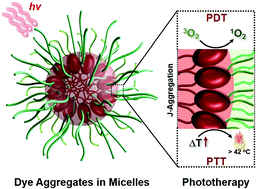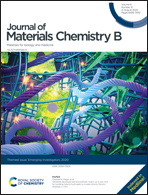Amphiphilic BODIPY dye aggregates in polymeric micelles for wavelength-dependent photo-induced cancer therapy†
Abstract
Near-infrared (NIR) light-responsive nanoparticles of organic small-molecule dyes hold great promise as phototherapeutic dyes (PDs) for clinical translation due to their intrinsic merits, including well-defined structure, high purity, and good reproducibility. However, they have been explored with limited success in the development of photostable NIR PDs with extraordinary photoconversion for highly effective phototherapy. Herein, we have described amphiphilic BODIPY dye aggregates within the polymeric micelles (Micelles) as potent bifunctional PDs for dually cooperative phototherapy under NIR irradiation. Micelles possessed an intensive NIR absorption, high photostability, and favorable non-radiative transition, thereby exhibiting both remarkable singlet oxygen generation and photothermal effect under NIR light irradiation. Besides, Micelles had preferable cellular uptake, effective cytoplasmic drug translocation as well as enhanced tumor accumulation. Owing to the combined virtues, Micelles showed clinical potential as bifunctional PDs for photo-induced cancer therapy. This work thus provides a facile strategy to exploit advanced PDs for practical phototherapeutic applications.

- This article is part of the themed collection: Journal of Materials Chemistry B Emerging Investigators


 Please wait while we load your content...
Please wait while we load your content...